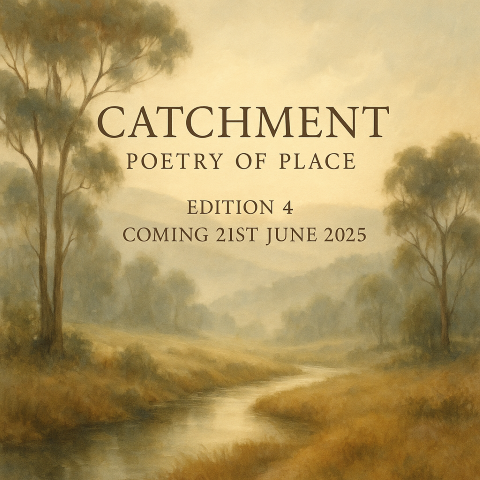This is the release date for Issue 4 of Catchment – Poetry of Place, to be found at Latest Edition. Readers may already have perused our earlier essays – here’s a new evaluation of topographic verse by Kris Hemensley too.
Formerly the poetry editor for so prominent a literary quarterly as Meanjin, long back (in the mid-1970s), Hemensley’s poems can be found in significant collections such as The Penguin Book of Modern Australian Poetry (eds. John Tranter & Phillip Mead, 1991) & The Oxford Book of Australian Religious Verse (ed. Kevin Hart, 1996).
Until quite recently, he was the proprietor of one of Australia’s most revered poetical bookshops, Collected Works.
Finding its last home upstairs in Cathedral Arcade, opposite St Paul’s, in Melbourne’s CBD, that iconic store was also staffed by Kris’ late wife Retta.
As a dimension likewise central to Catchment, location is intrinsic to Hemensley’s vast, ongoing set of poems still growing – across decades – under the title of Topography, with episodes therefrom included in all four issues from this online poetry journal so far.
Kris nods with empathy at an observation made – years back – by the Beat master-poet Gary Snyder, who joked that a major project called Mountains and Rivers Without End was threatening to be like its title.
As an aside, such a magnum opus did live up to this prediction, taking fully forty years to be completed: having commenced this in 1956, Snyder did not publish it as a whole until 1996.
Kris Hemensley can claim that Topography has a desk-life which stretches out even further.
Aged in his late seventies now, Kris notes – in his biographical statement in Catchment – that work on this lengthy series began (remarkably enough) as early as the mid-1960s.
At this point in time, during 2025, he is still writing such pieces, scratching them out by hand in sundry notebooks, before having them appear in periodicals, poetry broadsheets and chapbooks, typically prompted by a sense of place; by various moods and lines of thought.
New installments tend to be sparked by a blend of contexts, sources and reflections, as well as by human interactions, at times even set in coffee shops over at his beloved Elwood Beach, on Port Phillip Bay, or near his own home in Westgarth, in Melbourne’s inner-north.
Alas, his various topographic versifications have not been gathered into any overall collection, however, remaining unpublished as a whole: Hemensley estimates that the entire body of work could occupy as many as three volumes.
To work with him directly on putting further extracts through a keyboard onto a screen – so as to add to this larger ouvre – is one of my deepest delights as the editor of this journal.
Yet such a process brings with it points of interest, not least in terms of Kris’ acute focus on maintaining the integrity of decisions made at first instance, with wording and punctuation.
Approaches decided upon in over-scored notebook drafts – full of cross-outs – need to be retained religiously, during digital transcription of text, in the name of authenticity.
As a genuine Post-Modernist, Kris Hemensley has been known to say – smiling benignly – ‘No, no, no – you can open up brackets, of course, but you can never close them!’
He goes on to point out how another practice – specifying dates of composition at the start of Topography pieces – has been seen as suggesting that nothing is ever finished in reality.
With the whole still in its genesis, as a work-in-progress, the closing of brackets is frowned upon all the more, in other words, because this would bring a greater sense of conclusion.
Yet Hemensley’s habit of giving dates (instead of specific titles) reinforces another mantra also intrinsic to his method: once the drafting process has been completed, in that time and place, the work is not to be meddled with, through being reworked in hindsight.
Smiling wistfully, Kris recalls how Robert Duncan – as a major Black Mountain poet, visiting here from America, years back – felt deeply aggrieved by the prospect of a writer’s intentions potentially becoming compromised, due to editorial intrusion subsequently.
Still Kris agrees that being asked to make compromises, with layout on the printed page, in the name of house style, forfeits the integrity of notebook versions of poems well drafted.
As an example of Topography-based work, the piece that follows stays true to other long-established practices, somewhat more pivotal than a refusal to close brackets.
Readers will find deeper qualities, of course, evident in further poems already appearing in Catchment, as well as in Hemensley’s chapbook From the Blue Notebook (as published by Tim Wright of now orries press in 2022): this includes the piece dated 29-iii-22, given below.
Topography has an assuredness of voice, with the poetry cast in a register which can sound whimsical, even off-hand, before switching keys to concern; or frustration; perhaps despair.
All in all, Hemensley’s pitch in Topography is questing and discursive, as a poetry of ideas.
Hinting at cultural motifs embedded, his method does not shy away from posing challenges, with these not solely involving literary allusions which the reader is expected to grasp; but also in having the speaking voice shift scenes or alter moods, without gaps between stanzas.
As poetry of place, Topography offers readers direction by mapping out sampled sources as much as geographical locations, honouring ideas, phrases, drawn from the widest reading: it brings rewards with its humour; heart; with the light it casts on poetry; locality; humanity.
*************************************
TOPOGRAPHY
Elwood —> Clifton Hill
29-iii-22
1-35pm two hours since the Urquhart Street
tree-loppers advanced the kill
of my roads -my poem’s- Respighi pines —
C. agreed she-oaks are the pines
foreigners including you K. might identify —now pine
as fronds & branches fall from top height
of automated platform (leisure i had
within the no-time-for anything to show her
pavement coated by pine-needles —umbre dusting
below blue-stone terrace as close as we’ll get
to older world’s ‘Rome’ (R. Sanesi
toast of that process —bless
exemplarity —brings an European finesse
to common-or-garden Anglo Topography
(at Elwood the tide’s up —Doc’s inlet caressed
now by the wash —no gulls on rocks
but crests on small breaking waves
surveyed from sea-wall (have
i been sleeping here? —call
Poem for what it is —dream of
the Dream of Life in the World
by one who was once Alive
Kris Hemensley
– From the Blue Notebook (chapbook), now orries press, Melbourne, 2022
*************************************
Across Topography, Kris Hemensley pays credit to other poets whom he respects: in another Catchment piece, for example, he gives recognition to Japanese writer Santoka, whose non-traditional work dares to defy conventions about the ways in which haiku should be written.
Admiring Thomas Hardy’s verse likewise, in another piece Hemensley celebrates how the revered Wessex writer identifies the possibility of a personal farewell being given in spirit, when sunlight flashes off a metal plate on the coffin of Dorset dialect poet William Barnes.
In the topographic piece under focus here (dated 29-iii-22), Kris Hemensley acknowledges two significant creative contributors within Italian culture, across the Twentieth Century.
First off, in quite a minimal way, he pays tribute to Ottorini Respighi, as the composer of Pini di Roma (Pines of Rome): reading beyond the poem itself will establish that this was a musical tone poem, written to celebrate the Italian capital through focussing upon its trees.
In turn extending to a first initial, if not a full given name, Hemensley gives a ‘toast of that process’ for Roberto Sanesi, describing him as showing ‘exemplarity’ that we should ‘bless.’
For those of us who might not know, research will reveal him to have been a poet and translator held in high regard in that country: he rendered the work of T. S. Eliot into Italian.
While both figures in its central phase share cultural links to Italy, the opening and closing parts of this poem, as composed on March 29th, 2022, resonate against one another also.
Effectively Hemensley uses a book-ended structure, discernible once we look at this whole piece of work more closely, since its start and end show sorrow, remorse, in their own ways.
Before giving an eye and ear to Roman pines, the poet addresses himself in the third person.
Another character (also identified by only an initial, C.) jokes how Kris does not recognise native she-oaks as having needles too, given his migrant eye, teasing him as a ‘foreigner.’
Born in England, making a home here when younger, Hemensley finds merit in ‘European finesse’, laughing himself at the prosaic limits of ‘common-or-garden Anglo Topography.’
A sudden move in location, over to Elwood, brings a considerable change of mood, with the seaside throwing up sense-based imagery, visual in nature, focussing upon waves and gulls, rocks and sea-walls, matched by a gentle lyricism in language (‘caressed now by the wash’).
While shifting from one point of focus to another, Hemensley pays close attention to musicality in language, helping to bind together writing that could feel disparate otherwise.
Involving assonance (‘umbre dusting’), the poetry chimes with further echoes also, having fractional rhymes as well as full ones: ‘Sanesi’/ ‘bless’/ ‘finesse’/ ‘Topography’/ ‘caressed’.
As the poem ends, the sense of mortality grieved for (with trees felled at the start of the piece) re-emerges, with other twists: unexpected; personalised; exploring reality; creativity.
Surprising his readers by asking, ‘have/ i been sleeping here?’ Hemensley brings to mind a haunting question posed by John Keats in his ‘Ode to a Nightingale’: ‘Do I wake or sleep?’
The poet’s speaking voice here urges itself to be honest about being able to ‘call/ Poem for what it is,’ speculating on whether this created artefact is just illusory – no more substantial or real than a ‘dream of/ the Dream of Life in the World,’ circular, self-deceptive, pointless.
Reflecting on yet another plane, this poem goes even further in its last line, recalling Hardy: in ‘Channel Firing’, the noise from cannon in war is so disturbing as to bring the dead to life.
In the last phase of Hemensley’s piece, we find more unexpected capitalisation, yet this writing is surprising in larger ways too: across its twenty-two lines, the scope of this poem has expanded greatly, having begun with anger at trees in a street being felled insensitively.
Kris Hemensley takes us to thought-provoking levels, well above and beyond elevated views open to arborists, who have eyed off a ‘kill’ on an ‘automated platform,’ back in Northcote.
After going on to recognise noteworthy figures in Italian culture, Hemensley shifts ground yet again, not simply over to Port Phillip Bay, but to questioning his creative outcomes also.
In asking if his own last thoughts come from dream in sleep, this proves confronting enough.
This wide-ranging Topography piece from 29-iii-22 makes surprising shifts till its very end, with readers jolted by the idea of those final grim speculations coming from ‘one who was once Alive,’ as if Kris Hemensley sees himself (in being the poet) as somehow already dead.
*************************************
21-vi-25
among a set of verse-makings
charting the lay of the land
from mostly March 2022
(drawn from both a notebook
and a chapbook
each coloured blue
this one is exemplary
enough to warrant
a toast: K., bless you…
Rodney Williams
Editor
Catchment – Poetry of Place

